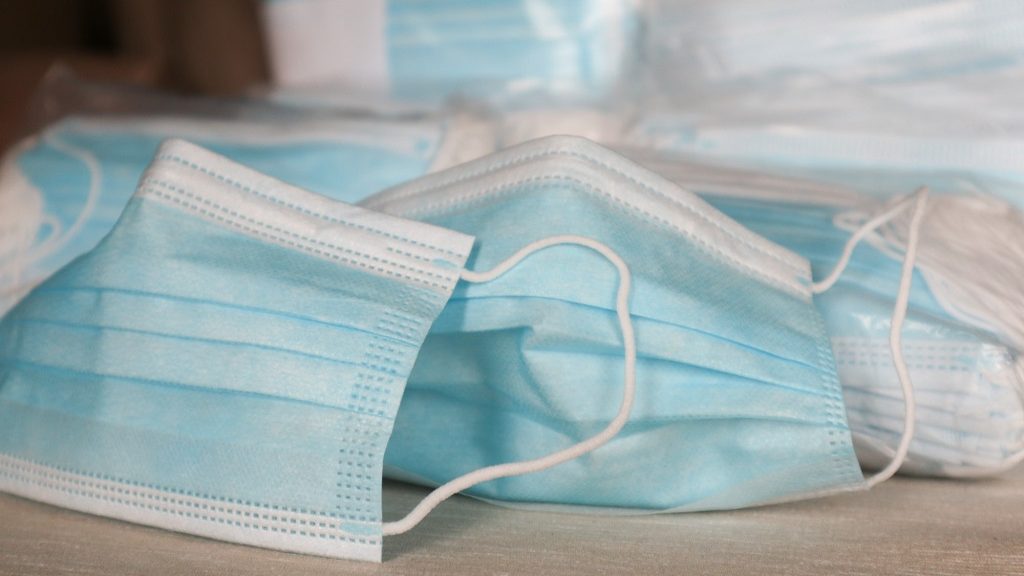Ontario faced a shortage of personal protective equipment at the onset of the COVID-19 pandemic in part because it did not replenish its stockpiles over the previous years, an independent commission examining the impact of the health crisis on long-term care has heard.
Ontario’s former deputy minister of health and long-term care, Bob Bell, told the independent commission that the province’s supply of personal protective equipment should have been refilled around 2017 or 2018, under the previous and current provincial regimes.
Bell, who served as deputy minister for four years until mid-2018 and now chairs an advisory panel for the Revera chain of nursing homes, said there was no conscious decision to let the stockpiles dwindle. The issue simply fell through the cracks, he said.
“In the midst of everything else that goes on in government, the decision to replenish stockpiles was not undertaken as an affirmative action kind of thing that should have been done,” he said in his Dec. 21 testimony that was posted online recently.
He also said the move to destroy expired N95 masks was, in hindsight, “not a smart decision” because only the elastic posed a potential problem and the masks still had “ventilatory capacity.”
As a result, he said, there was not enough personal protective equipment in the provincial health system when the COVID-19 pandemic hit early last year, and skyrocketing demand made it difficult to obtain once the crisis began.
What’s more, the personal protective equipment that was available was largely earmarked for hospitals rather than long-term care, he said.
“We also focused the stocks distributed to the hospital sector thinking that, should a pandemic arise … the response will be led by hospitals,” he said.
“That’s what happened in 2003 (with SARS). That’s what would have happened with Ebola, and that’s where we focused our stocks of PPE.”
Dr. Samir K. Sinha, director of geriatrics for the Sinai Health System and the University Health Network, told the commission that other jurisdictions, such as British Columbia, were able to deploy their supply of personal protective equipment more efficiently than Ontario and get it to the long-term care system faster.
Sinha, who is also on the Revera advisory panel, said the B.C. government took control of the province’s entire supply of personal protective equipment and distributed it with a science-based approach, preventing any “unnecessary hoarding.”
“As they had prioritized long-term care and congregated care settings early on, they were able to actually get PPE very quickly to those settings, including to primary care practices, much earlier on than we were able to get in Ontario,” he said.
A spokesperson for the minister of health did not immediately respond to a request for comment Thursday.
More than 2,900 long-term care residents and 10 staff members have died as a result of COVID-19 since the start of the pandemic. Of the province’s 626 long-term care homes, 218 reported an active outbreak on Thursday.
The independent commission, led by the Superior Court’s associate chief justice Frank Marrocco, isn’t open to the public, but transcripts of testimony are later posted online.

The Ford government has given the go-ahead for the Ottawa Senators and Toronto Maple Leafs to play home games in their respective arenas when the new NHL season gets underway.
The two teams are set to play in an all-Canadian division when the NHL season starts Jan. 13.
The league and its teams are set to play an abbreviated 56-game season and has realigned its divisions in order to limit travel during the pandemic, especially as the Canadian border remains closed.
Lisa MacLeod, the Minister of Heritage, Sport, Tourism and Culture Industries says the approval was granted after close scrutiny of the rigorous health and safety protocols that have been adopted to keep players, staff, and communities safe from the spread of COVID-19.
“I look forward to continued work with both the Toronto Maple Leafs and the Ottawa Senators on a public relations campaign to warn Ontarians against the spread of COVID-19 and to rebuild confidence in minor sports post pandemic,” she said in a statement.
However, at around the same time her announcement was made public, Dr. David Williams – the province’s top doctor – seemed unaware of MacLeod’s statement.
“We are assessing that at this time, we have not made a final decision [but] it’s getting very close,” he said during his daily provincial update. “I haven’t signed off on it at this time.”
The decision comes as the province of Ontario is currently in a lockdown which prevents minor hockey organizations from getting together and playing games.
The federal government gave the start of training camps a thumbs up and also waived the 14-day quarantine rule under “national interest grounds” in favour of a modified plan for players and team staff returning to the country.
The Maple Leafs are set to start the season at home against the Montreal Canadiens on opening night while the Senators will play host to the Maple Leafs two nights later on Jan. 15.
British Columbia, Alberta and Quebec have already given approval for their respective teams while Manitoba has yet to officially clear the Winnipeg Jets to play at home, but has expressed confidence they will be able to.
Files from The Canadian Press were used in this report
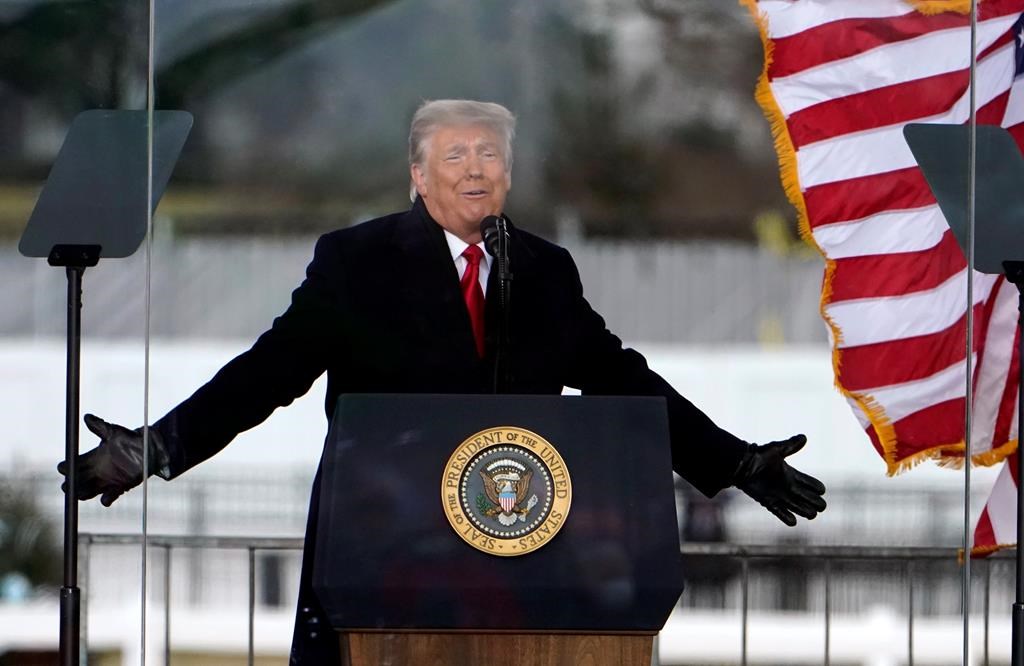
President Donald Trump condemned the “heinous attack” of the U.S. Capitol in his return to Twitter on Thursday evening, adding he was “outraged by the violence, lawlessness and mayhem.”
Trump also promised “a smooth, orderly and seamless transition of power” in a video posted on the social medial platform, which had suspended him from tweeting for 12 hours on Wednesday evening.
“To those who engaged in the acts of violence and destruction, you do not represent our country, and to those who broke the law, you will pay, ” he said, in stark contrast to his tone the previous day.
https://twitter.com/realDonaldTrump/status/1347334804052844550?ref_src=twsrc%5Etfw%7Ctwcamp%5Etweetembed%7Ctwterm%5E1347334804052844550%7Ctwgr%5E%7Ctwcon%5Es1_&ref_url=https%3A%2F%2Ftoronto.citynews.ca%2F2021%2F01%2F07%2Ftrump-returns-to-twitter-with-video-condemning-rioters%2F
Trump’s suspension from the platform came after three tweets that Twitter deemed a breach of their Civic Integrity policy, including a video in which Trump addressed the riotous, violent mob that stormed the U.S. Capitol in an attempt to halt the confirmation of Biden’s presidential election win.
n that video he commiserated with the mob and reiterated that the election was stolen from him while also gently asking them to go home.
“I know your pain. I know your hurt. But you have to go home now,” he said. “We can’t play into the hands of these people. We have to have peace. So go home. We love you. You’re very special,” he said.
In Thursday’s video, Trump claimed he “immediately deployed the national guard,” to quell the violence, in contradiction to reports the previous day that it was Vice-President Mike Pence who spoke with senior defence leaders about calling up the National Guard.
He added that he contested the election results so fiercely because he was “fighting to defend American democracy” and believes elections laws need to be reformed. He added that he will now focus on a smooth and seamless transition of power.
“This moment calls for healing and reconciliation,” he said, just over 24 hours after his rally in Washington, which is believed to have sparked the hours-long riot thereafter.
As officials sifted through the aftermath of the pro-Trump mob’s siege of the U.S. Capitol, there was growing discussion of impeaching him a second time or invoking the 25th Amendment to oust him from the Oval Office.
The invasion of the Capitol building, a powerful symbol of the nation’s democracy, rattled Republicans and Democrats alike. They struggled with how best to contain the impulses of a president deemed too dangerous to control his own social media accounts but who remains commander in chief of the world’s greatest military.
“I’m not worried about the next election, I’m worried about getting through the next 14 days,” said Republican Sen. Lindsey Graham of South Carolina, one of Trump’s staunchest allies. He condemned the president’s role in Wednesday’s riots and said, “If something else happens, all options would be on the table.”
Democratic House Speaker Nancy Pelosi declared that “the president of the United States incited an armed insurrection against America.” She called him “a very dangerous person who should not continue in office. This is urgent, an emergency of the highest magnitude.”
Neither option to remove Trump seemed likely, with little time left in his term to draft the Cabinet members needed to invoke the amendment or to organize the hearings and trial mandated for an impeachment. But the fact that the dramatic options were even the subject of discussion in Washington’s corridors of power served as a warning to Trump.
Fears of what a desperate president could do in his final days spread in the nation’s capital and beyond, including speculation Trump could incite more violence, make rash appointments, issue ill-conceived pardons – including for himself and his family – or even trigger a destabilizing international incident.
Files from The Associated Press were used in this report

As surging COVID-19 infections intensify the strain on the province’s health-care system, hospitals have been told by the Ontario government to prepare for the transfer of potentially hundreds of patients across regions.
In a memo to hospitals Thursday obtained by CityNews, Ontario Health president and CEO Matthew Anderson said they must be ready to accept patients from other hospitals in and outside their regions, “when directed by their regional COVID-19 response structure.”
According to the memo, updated projections show the province will see more than 500 COVID-19 patients in intensive care units, and more than 1,700 hospitalizations related to the virus before the end of the month.
Several Toronto area hospitals announced Thursday they are closing their pediatric wards to help create adult inpatient capacity.
Unity Health Toronto said in a statement its St. Joseph’s site, along with William Osler Health System and Humber River Hospital, may transfer pediatric patients who need to be hospitalized to SickKids, where there is capacity.
“Our youngest patients remain a top priority, and we continue to provide consultative, neonatal and ambulatory care for all our pediatric patients, including at our Just For Kids Clinic, Paediatric Consultation Clinic and Neonatal Intensive Care Unit,” said the statement.
In the memo Anderson goes on to list “additional actions that hospitals must take immediately” to make sure people get the care they need.
Hospitals that have unoccupied intensive care beds must reserve approximately one-third of those beds for transfers from hospitals that have no ICU capacity.
The transfers of ICU patients between hospitals will be managed by the Ontario-wide Critical Care COVID-19 Command Centre.
Hospitals in COVID hotspots will continue “time-sensitive” surgeries and procedures, including certain cancer treatments, transplants, cardiac and neurological care. And the hospitals must “have a plan in place to appropriately defer non-time-sensitive care.”
“We need to work as a provincial system at a level never required before,” Anderson said in the memo. “This means that no hospitals should feel they are on their own.”
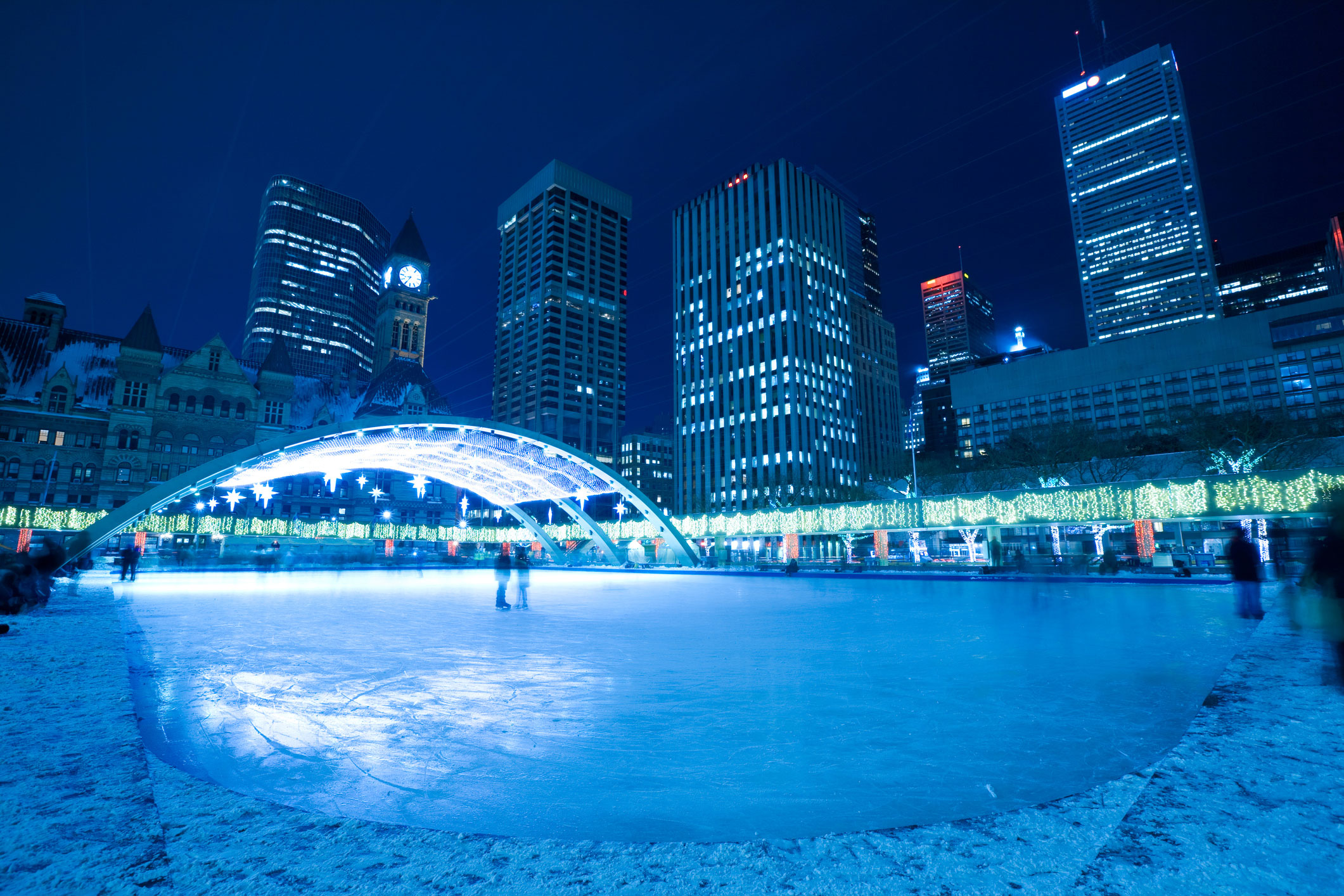
For families that are looking to get outside and enjoy some time on the ice, the city of Toronto has made outdoor skating available to those who reserve spaces. There is a 25-person limit for outdoor ice rinks, and while reservations are encouraged, a small number of spots will be available for participants who are not able to make a reservation online.
TORONTO SKATING TIPS:
- Skaters should plan ahead as reservations are encouraged and capacity is limited to 25 people per ice pad at all times.
- Reservations for 45-minute skating sessions can be made online at toronto.ca/skate, although a limited number of spots will be available for people who are not able to make a reservation online.
- To reserve a skating session, people need client and family PIN numbers. These numbers can be requested by calling 416-396-7378. Call centre hours have been expanded to 8 am to 8 pm Monday to Friday, and Saturday and Sunday 9 am to 3 pm.
- It is important for people to check their rink’s open/closed status before heading out. This information is updated with weather-related or other service disruptions and is available on toronto.ca/skate.
- A complete listing of ice rink locations and skate session availability can be found at toronto.ca/skate. The webpage includes:
- A mapping function as well as a listing of rinks
- The ability to search by location or address
- The ability to filter by skating trail or skate rentals
- The ability to reserve directly from a location in the listing
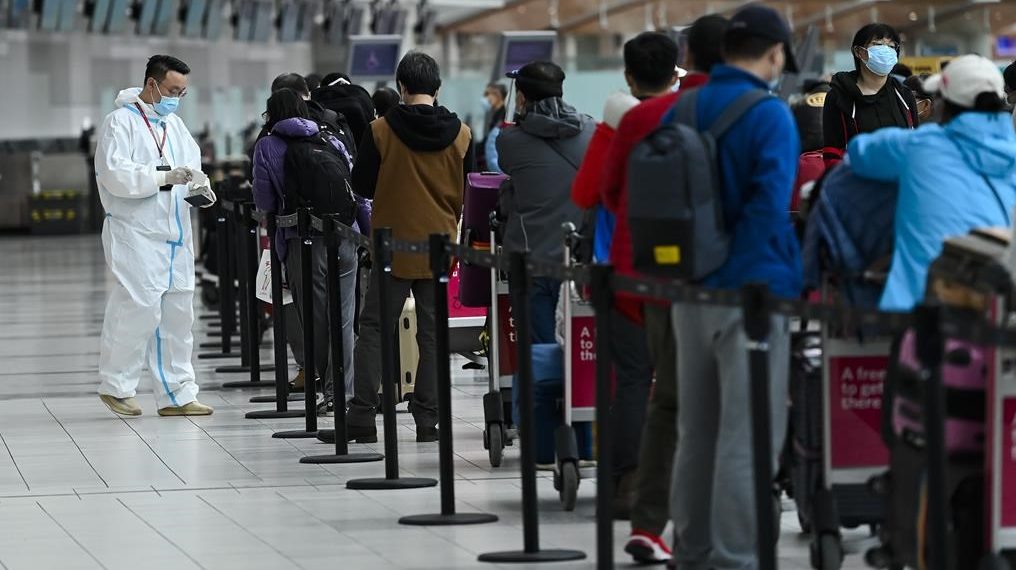
Canada’s ban on flights from the United Kingdom is not being extended, replaced by a stringent COVID-19 testing program for air travellers.
Canada halted most air travel from the U.K., where a mutated strain of COVID-19 had been discovered, on Dec. 20.
New rules that require passengers returning from abroad to show proof of negative COVID-19 test results will prevent the virus from bleeding across borders, Transport Minister Marc Garneau said.
Effective Thursday, passengers aged five and older must take a PCR test – the type of test common in Canada involving a deep nasal swab, and distinct from a rapid test.
The test has to be administered less than 72 hours before the scheduled departure, or 96 hours in the cases of 28 countries and territories, mainly in the Caribbean and South America, Garneau said at a virtual press conference. The four-day timeframe for those 28 jurisdictions shrinks to three days as of Jan. 14, however.
Airlines say they were not initially consulted on the testing scheme, which they will be responsible for enforcing at check-in counters around the globe.
Cabinet ministers appealed to Canadians to stay on home turf as coronavirus case counts reach new daily highs, and as some federal and provincial politicians take heat and lose jobs over holiday trips abroad.
“We strongly, strongly, strongly recommend to avoid all non-essential travel outside of Canada,” said Foreign Affairs Minister Francois-Philippe Champagne.
“Canadians are understandably concerned and upset about these travellers,” added Public Safety Minister Bill Blair.
“There is not just a legal obligation but a moral one … Lives are at stake. We have already lost far too many people.”
Airlines and passengers have raised concerns about testing capacity in some countries, with the fear that some travellers could wind up stranded overseas.
“We consider that it is perfectly reasonable within 72 hours to get the PCR test and to get results” – electronically or on paper – Garneau told reporters.
But Health Minister Patty Hajdu acknowledged that the requirement serves as a deterrent.
“This is exactly why we are advising people not to travel internationally,” she said. “The reality is they may find it difficult even in countries that have the PCR testing capacity to acquire a test within the required timeframe.”
Airlines are scrambling to draw up lists of overseas agencies and test centres for travellers to use, though Garneau said Transport Canada may publish a similar list down the line.
Conservative transport critic Stephanie Kusie called the plan “unacceptable” and suggested the Liberals remodel it based on a pilot project underway at Calgary’s airport.
Canadians can take on-site COVID-19 tests after touching down there, and must then self-isolate for 24 to 48 hours while they wait for results. If they test negative, they can leave quarantine but must monitor themselves for symptoms and get second swabs within six to seven days of their arrival date.
“Now, in a hastily conceived plan announced six days ago, on New Year’s Eve, without any consultation or coordination with Canada’s airlines, the Liberal government has imposed a poorly thought out testing requirement with little information and few resources to execute,” Kusie said in a statement.
In a separate announcement, Ontario said it will launch a pilot program to voluntarily test incoming passengers at Toronto’s Pearson airport.
Some uncertainty lingers around the federal rules.
It is unclear whether airlines whose flights are cancelled and rebooked days later – a common occurrence since March as demand collapsed – will accept tests administered within the timeframe of the initially scheduled departure but not within 72 hours of the rescheduled trip, said Air Transat spokesman Christophe Hennebelle.
Garneau’s spokeswoman Allison St-Jean said carriers can fall back on the originally scheduled takeoff time in “unforeseen circumstances” such as bad weather or mechanical delays.
Other requirements have tightened since the basic plan was announced last Thursday.
It stated travellers from countries where testing was unavailable could return, but would have to spend their quarantine in a “federal facility.” Now, only two places – Haiti and Saint Pierre and Miquelon, a French territory off the coast of Newfoundland – are exempt from the test mandate, and only until Jan. 21 and Jan. 14, respectively.
Border agents will question and observe arriving passengers at four airports – Toronto, Montreal, Vancouver and Calgary – with 230 officers set to question travellers at customs halls, baggage areas and inspection lines since late December, Blair said.
About 180 more federal public health officers have also been posted to points of entry across the country, he said.
Before departure, airlines will continue to take passengers’ temperatures, ask questions including whether they’ve been exposed to anyone with COVID-19 and assess them for symptoms, Garneau said.
Returning travellers will have to submit a health questionnaire through the ArriveCAN app or web portal.

Twitter has suspended U.S. President Donald Trump’s Twitter account for 12 hours after he posted “repeated and severe violations of [their] Civic Integrity policy.”
Trump had three tweets removed on Wednesday afternoon, including a video message posted as his supporters stormed the U.S. Capitol.
In the pre-taped video, Trump told supporters the election was stolen from them but also asked them to go home.
“I know your pain. I know your hurt. But you have to go home now,” he said. “We can’t play into the hands of these people. We have to have peace. So go home. We love you. You’re very special.”
The video statement came shortly after President-elect Joe Biden urged Trump to address his supporters and was taken down shortly after by Twitter, Facebook and YouTube.
The statement posted on @TwitterSafety says future violations could result in the permanent suspension of his Twitter account.
Trump currently has 88.7 million followers on the social media platform.
Facebook and Instagram, which Facebook owns, later announcing that Trump wouldn’t be able to post for 24 hours following two violations of its policies. The White House did not immediately offer a response to the actions.
While some cheered Twitter’s actions, experts noted that the companies’ actions follow years of hemming and hawing on Trump and his supporters spreading dangerous misinformation and encouraging violence that have contributed to Wednesday’s violence.
Jennifer Grygiel, a Syracuse University communications professor and an expert on social media, said Wednesday’s events in Washington, D.C. are a direct result of Trump’s use of social media to spread propaganda and disinformation, and that the platforms should bear some responsibility for their inaction.
“This is what happens,” said Grygiel, who uses they/them pronouns. “We didn’t just see a breach at the Capitol. Social media platforms have been breached by the president repeatedly. This is disinformation. This was a coup attempt in the United States.”
Grygiel said the platform’s decision to remove the video – and Twitter’s suspension – are too little, too late.
“They’re creeping along towards firmer action,” they said, calling Trump “Exhibit A” for the need for greater regulation of social media. “Social media is complicit in this because he has repeatedly used social media to incite violence. It’s a culmination of years of propaganda and abuse of media by the president of the United States.”
Guy Rosen, Facebook’s vice-president of integrity, said on Twitter Wednesday that the video was removed because it “contributes to rather than diminishes the risk of ongoing violence.”
“This is an emergency situation and we are taking appropriate emergency measures, including removing President Trump’s video,” Rosen said on Twitter.
Trump has harnessed social media – especially Twitter – as a potent tool for spreading misinformation about the election. Wednesday’s riot only increased calls to ban Trump from the platform.
“The President has promoted sedition and incited violence,” Jonathan Greenblatt, chief executive officer of the Anti-Defamation League said in a statement. “More than anything, what is happening right now at the Capitol is a direct result of the fear and disinformation that has been spewed consistently from the Oval Office.”
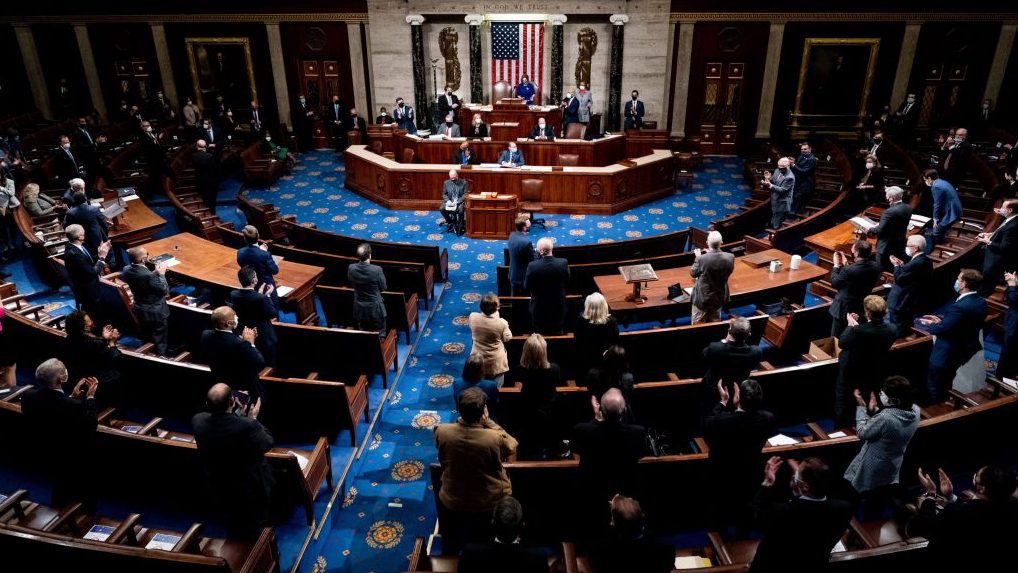
Congress confirmed Democrat Joe Biden as the presidential election winner early Thursday after a violent mob loyal to President Donald Trump stormed the U.S. Capitol in a stunning attempt to overturn America’s presidential election, undercut the nation’s democracy and keep Trump in the White House.
Lawmakers were resolved to complete the Electoral College tally in a display to the country, and the world, of the nation’s enduring commitment to uphold the will of the voters and the peaceful transfer of power. They pushed through the night with tensions high and the nation’s capital on alert.
Before dawn Thursday, lawmakers finished their work, confirming Biden won the election.
Vice-President Mike Pence, presiding over the joint session, announced the tally, 306-232.
Trump, who had repeatedly refused to concede the election, said in a statement immediately after the vote that there will be a smooth transition of power on Inauguration Day.
“Even though I totally disagree with the outcome of the election, and the facts bear me out, nevertheless there will be an orderly transition on January 20th,” Trump said in a statement posted to Twitter by an aide.
The Capitol was under siege Wednesday, as the nation’s elected representatives scrambled to crouch under desks and don gas masks while police futilely tried to barricade the building, one of the most jarring scenes ever to unfold in a seat of American political power. A woman was shot and killed inside the Capitol, and Washington’s mayor instituted an evening curfew in an attempt to contain the violence.
The rioters were egged on by Trump, who has spent weeks falsely attacking the integrity of the election and had urged his supporters to descend on Washington to protest Congress’ formal approval of Biden’s victory. Some Republican lawmakers were in the midst of raising objections to the results on his behalf when the proceedings were abruptly halted by the mob.
Together, the protests and the GOP election objections amounted to an almost unthinkable challenge to American democracy and exposed the depths of the divisions that have coursed through the country during Trump’s four years in office. Though the efforts to block Biden from being sworn in on Jan. 20 were sure to fail, the support Trump has received for his efforts to overturn the election results have badly strained the nation’s democratic guardrails.
Congress reconvened in the evening, with lawmakers decrying the protests that defaced the Capitol and vowing to finish confirming the Electoral College vote for Biden’s election, even if it took all night.
Pence reopened the Senate and directly addressed the demonstrators: “You did not win.”
Republican Senate Majority Leader Mitch McConnell said the “failed insurrection” underscored lawmakers’ duty to finish the count. Democratic House Speaker Nancy Pelosi said Congress would show the world “what America is made of” with the outcome.
The president gave his supporters a boost into action Wednesday morning at a rally outside the White House, where he urged them to march to the Capitol. He spent much of the afternoon in his private dining room off the Oval Office watching scenes of the violence on television. At the urging of his staff, he reluctantly issued a pair of tweets and a taped video telling his supporters it was time to “go home in peace” — yet he still said he backed their cause.
Hours later, Twitter for the first time time locked Trump’s account, demanded that he remove tweets excusing violence and threatened “permanent suspension.”
A sombre President-elect Biden, two weeks away from being inaugurated, said American democracy was “under unprecedented assault,” a sentiment echoed by many in Congress, including some Republicans. Former President George W. Bush said he watched the events in “disbelief and dismay.”
The domed Capitol building has for centuries been the scene of protests and occasional violence. But Wednesday’s events were particularly astounding both because they unfolded at least initially with the implicit blessing of the president and because of the underlying goal of overturning the results of a free and fair presidential election.
Tensions were already running high when lawmakers gathered early Wednesday afternoon for the constitutionally mandated counting of the Electoral College results, in which Biden defeated Trump, 306-232. Despite pleas from McConnell, more than 150 GOP lawmakers planned to support objections to some of the results, though lacking evidence of fraud or wrongdoing in the election.
Trump spent the lead-up to the proceedings publicly hectoring Pence, who had a largely ceremonial role, to aid the effort to throw out the results. He tweeted, “Do it Mike, this is a time for extreme courage!”
But Pence, in a statement shortly before presiding, defied Trump, saying he could not claim “unilateral authority” to reject the electoral votes that make Biden president.
In the aftermath of the siege, several Republicans announced they would drop their objections to the election, including Sen. Kelly Loeffler, R-Ga., who lost her bid for reelection Tuesday.
Earlier, protesters had fought past police and breached the building, shouting and waving Trump and American flags as they marched through the halls, many without masks during the COVID-19 crisis. Lawmakers were told to duck under their seats for cover and put on gas masks after tear gas was used in the Capitol Rotunda. Some House lawmakers tweeted they were sheltering in place in their offices.
Rep. Scott Peters, D-Calif., told reporters he was in the House chamber when rioters began storming it. Security officers “made us all get down, you could see that they were fending off some sort of assault.”
He said they had a piece of furniture up against the door. “And they had guns pulled,” Peters said. Glass panes to a House door were shattered.
The woman who was killed was part of a crowd that was breaking down the doors to a barricaded room where armed officers stood on the other side, police said. She was shot in the chest by Capitol Police and taken to a hospital where she was pronounced dead. City police said three other people died from medical emergencies during the long protest on and around the Capitol grounds.
Staff members grabbed boxes of Electoral College votes as the evacuation took place. Otherwise, said Sen. Jeff Merkley, D-Ore., the ballots likely would have been destroyed by the protesters.
The mob’s storming of Congress prompted outrage, mostly from Democrats but from Republicans as well, as lawmakers accused Trump of fomenting the violence with his relentless falsehoods about election fraud.
“Count me out,” said Trump ally Sen. Lindsey Graham, R-S.C. “Enough is enough.”
Several suggested that Trump be prosecuted for a crime or even removed under the Constitution’s 25th Amendment, which seemed unlikely two weeks from when his term expires.
“I think Donald Trump probably should be brought up on treason for something like this,” Rep. Jimmy Gomez, D-Calif., told reporters. “This is how a coup is started. And this is how democracy dies.”
Sen. Ben Sasse, R-Neb., who has at times clashed with Trump, issued a statement saying: “Lies have consequences. This violence was the inevitable and ugly outcome of the President’s addiction to constantly stoking division.”
Despite Trump’s repeated claims of voter fraud, election officials and his own former attorney general have said there were no problems on a scale that would change the outcome. All the states have certified their results as fair and accurate, by Republican and Democratic officials alike.
Punctuating their resolve, both the House and Senate soundly rejected an objection to election results from Arizona, which had been raised by Sen. Ted Cruz, R-Texas, and Rep. Paul Gosar, R-Ariz., and another from Pennsylvania brought by Sen. Josh Hawley, R-Mo., and Rep. Scott Perry, R-Pa. Still, most House Republicans supported the objections. Other objections to results from Georgia, Michigan, Nevada and Wisconsin fizzled.
The Pentagon said about 1,100 District of Columbia National Guard members were being mobilized to help support law enforcement at the Capitol. Dozens of people were arrested.
Associated Press writers Jill Colvin, Zeke Miller, Kevin Freking, Alan Fram, Matthew Daly, Ben Fox and Ashraf Khalil in Washington and Bill Barrow in Atlanta contributed to this report.
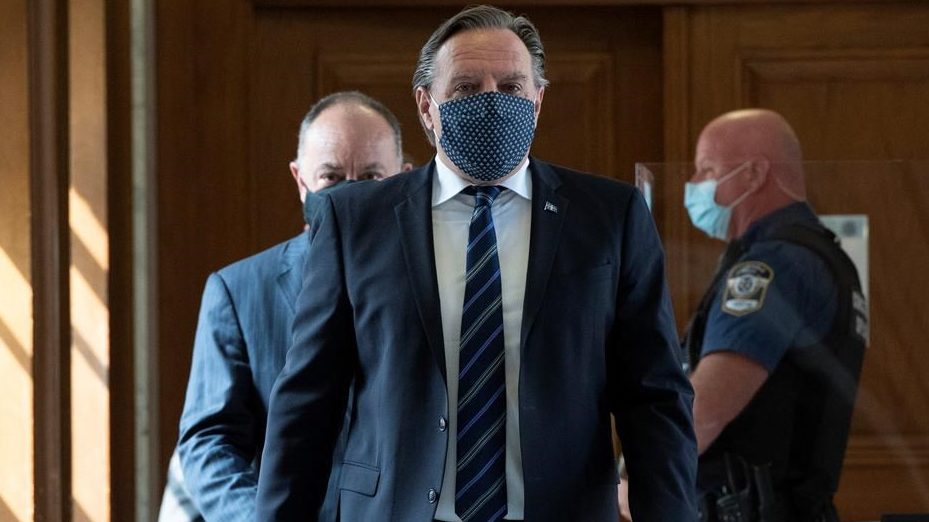
Quebecers need to be jolted into recognizing the seriousness of the COVID-19 pandemic, Premier Francois Legault said Wednesday, before announcing a provincewide 8 p.m. curfew for the next four weeks.
Legault said despite the fact schools, retail stores and many other businesses have been closed since December, COVID-19 infections and related hospitalizations continue to rise. Too many seniors are ending up in hospital after becoming infected in private homes, he added.
“We are obliged to provide a type of shock treatment so that people reduce their visits,” he told reporters. Quebec will become the first province in the country to impose such a drastic measure to curb the spread of the novel coronavirus.
Beginning Saturday and until at least Feb. 8, Quebecers will be under a curfew from 8 p.m. to 5 a.m., Legault said, adding that anyone caught breaking the rules is liable to a fine between $1,000 and $6,000. The government is considering creating a document for people who have to be out after the curfew, which they can show police.
“When we say we are giving an electroshock it’s really for four weeks, a period that should make a difference,” Legault said.
“The police are important allies in the fight against the virus,” he added. “I need the police and Quebec needs the police to be able to succeed with this shock treatment during the next four weeks.”
The premier said all non-essential businesses that he ordered closed in December will remain closed until at least Feb. 8, when the curfew is scheduled to be lifted.
Legault, however, said primary schools will reopen as scheduled, on Jan. 11, and high school students will return to in-person learning the week after, on Jan. 18. “Our children have to be able to continue to learn,” he said.
Speaking before Legault’s news conference, Dr. Donald Sheppard, chair of the microbiology and immunology department at McGill University, said the government needed to explain the logic behind a curfew because the majority of outbreaks documented by public health have been in workplaces and schools.
Public health director Dr. Horacio Arruda said the curfew is part of a series of measures aimed at reducing the possibility of gatherings and of contact between people. “There’s no science that can tell you what measure will have what percentage effect,” he told reporters.
Arruda said he believes many small gatherings around Christmas led to the large number of COVID-19 cases being reported in Quebec.
Earlier on Wednesday, Quebec reported 2,641 new COVID-19 infections and 47 more deaths attributed to the novel coronavirus. The Health Department said hospitalizations jumped by 76, to 1,393 – the largest number since late May – and 202 people were in intensive care, a rise of eight.
Despite calls from some health experts to shut down the manufacturing and construction sectors, Legault said the government won’t close factories or order work sites to stop operating. Factories, he said, have been asked to postpone “non-essential” manufacturing. The type of production that will be designated “essential” will be decided, he explained, following discussions between manufacturers and government officials.
The majority of people in hospital with COVID-19 are over 65 years old and are unlikely working in the manufacturing sector, Legault said, in an attempt to explain his decision. Arruda said many factories are producing essential products such as food and can’t be closed.
Quebec’s health-care system is under heavy strain, Health Minister Christian Dube said, adding that some kidney transplants have been cancelled. That sort of strain is worrying for experts like Sheppard who said surgeries and cancer screenings are being put off and intensive care units are filling up,
“The biggest worry is, eventually, if we don’t do anything, we’ll get to the point where it’s going to be the decision where we have two patients, one ventilator and someone has to decide,” Sheppard said in an interview Wednesday.
He said the impact of cancelled procedures is already being felt: breast cancer patients are presenting with larger tumours than they were before the pandemic, a sign that they’re being diagnosed late.
Quebec’s INESSS institute, a government-mandated health-care think tank, warned on Dec. 31 that hospitals in the Montreal area are likely to run out of dedicated COVID-19 beds within three weeks.
Much of Quebec, including the province’s largest cities, has been under partial lockdown since October, when bars, restaurant dining rooms, gyms and entertainment venues were closed. In December, Legault closed all “non-essential” retail stores and extended the winter break for elementary and high school students.
Quebec has reported an average of 2,597 new cases a day over the past week, Health Minister Christian Dube said on Twitter Wednesday.
That figure represents 300 cases a day per million people – more than any province in Canada. The next highest is Alberta with 233.8 cases per million, followed by Ontario with 221.9, according to a report released Wednesday by National Bank Financial Markets based on data from Johns Hopkins University.
Officials said 6,221 doses of vaccine were administered Tuesday, for a total of 38,984. Quebec has reported 217,999 COVID-19 infections and 8,488 deaths linked to the virus since the beginning of the pandemic.

The 2021 Grammy Awards will no longer take place this month in Los Angeles and will broadcast in March due to a recent surge in coronavirus cases and deaths.
The Recording Academy told The Associated Press on Tuesday that the annual show would shift from its original Jan. 31 broadcast to an unspecified date in March.
The Grammys will be held in Los Angeles at the Staples Center. Los Angeles County, the epicenter of the crisis in California, has surpassed 10,000 COVID-19 deaths and has had 40% of the deaths in California. It is the third state to reach the 25,000 death count.
An average of six people die every hour from COVID-19 in Los Angeles County, which has a quarter of the state’s 40 million residents. County health officials fear the incoming Christmas and New Year’s surge.
“The Daily Show” host and comedian Trevor Noah is set to host the 2021 Grammys, where Beyonce is leading contender with nine nominations. She scored nominations for song and record of the year with “Black Parade,” which she released on Juneteenth, while “Savage” _ her No. 1 collaboration with Megan Thee Stallion _ picked up bids for record of the year, best rap song and best rap performance.
Beyonce’s “Black Is King,” which aired on Disney+, is nominated for best music film while “Brown Skin Girl,” a song dedicated to dark- and brown-skinned women, is nominated for best music video. Her daughter Blue Ivy Carter sings on “Brown Skin Girl” and also earned a Grammy nomination.
Taylor Swift, Dua Lipa, Roddy Ricch, Jhene Aiko, Post Malone, Renee Zellweger, Billie Eilish and her producer-brother Finneas also scored nominations. First-time nominees include The Strokes, Megan Thee Stallion and Harry Styles.
Since the pandemic, a number of awards show were postponed and later revamped due to COVID-19 restrictions. The BET Awards was the first major awards show during the pandemic and was a success thanks to its artsy, highly produced, well-crafted pre-taped performances. The MTV Video Music Awards featured Lady Gaga winning awards and performing onsite in a mask, and the Latin Grammys pre-taped several performances the week of the show, handing out some of its awards to the winners who attended the show.
Performers at the upcoming Grammys will be announced at a later date.
